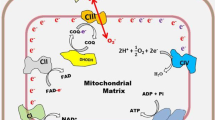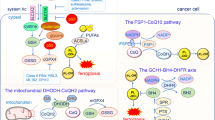Abstract
Pharmacologic ascorbate induced cell death and ferroptosis share common features such as iron dependency, production of ROS, lipid peroxidation, caspase independency and the possible involvement of autophagy. These observations lead us to hypothesize that ferroptosis may also be involved in cancer cell death due to pharmacologic ascorbate treatment. Thus cell death of HT-1080 cell line was induced by ferroptosis inducers and pharmacologic ascorbate then the mechanism of cell death was compared. The EC50 value of pharmacologic ascorbate on HT-1080 cell line was found to be 0.5 mM that is in the range of the most ascorbate sensitive cell lines. However either of the specific inhibitors of ferroptosis (ferrostatin-1 and liproxstatin-1) could not elevate the viability of pharmacologic ascorbate treated cells suggesting that ferroptosis was not involved in the pharmacologic ascorbate induced cell death. α-tocopherol that could effectively elevate the viability of erastin and RSL3 treated HT1080 cells failed to mitigate the cytotoxic effect of pharmacologic ascorbate further strengthened this assumption. Furthermore at lower concentrations (0.1–0.5 mM) ascorbate could avoid the effects of ferroptosis inducers. Our results indicate that pharmacologic ascorbate induced cytotoxicity and ferroptosis – albeit phenotypically they show similar traits – are governed by different mechanisms.









Similar content being viewed by others
References
Tóth SZ, Lőrincz T, Szarka A (2017) Concentration does matter: The beneficial and potentially harmful effects of ascorbate in humans and plants. Antioxid Redox Signal 00:ars.2017.7125
Liou G-Y, Storz P (2010) Reactive oxygen species in cancer. Free Radic Res 44:479–496
Rouleau L, Antony AN, Bisetto S, Newberg A, Doria C, Levine M, Monti DA, Hoek JB (2016) Synergistic effects of ascorbate and sorafenib in hepatocellular carcinoma: new insights into ascorbate cytotoxicity. Free Radic Biol Med 95:308–322
Kehrer JP (2000) The Haber-Weiss reaction and mechanisms of toxicity. Toxicology 149:43–50
Adachi T, Nonomura S, Horiba M, Hirayama T, Kamiya T, Nagasawa H, Hara H (2016) Iron stimulates plasma-activated medium-induced A549 cell injury. Sci Rep 6:20928
Mandl J, Szarka A, Bánhegyi G (2009) Vitamin C: update on physiology and pharmacology. Br J Pharmacol 157:1097–1110
Chen Q, Espey MG, Krishna MC, Mitchell JB, Corpe CP, Buettner GR, Shacter E, Levine M (2005) Pharmacologic ascorbic acid concentrations selectively kill cancer cells: action as a pro-drug to deliver hydrogen peroxide to tissues. Proc Natl Acad Sci U S A 102:13604–13609
Chen Q, Espey MG, Sun AY, Pooput C, Kirk KL, Krishna MC, Khosh DB, Drisko J, Levine M (2008) Pharmacologic doses of ascorbate act as a prooxidant and decrease growth of aggressive tumor xenografts in mice. Proc Natl Acad Sci 105:11105–11109
Parrow NL, Leshin JA, Levine M (2013) Parenteral ascorbate as a cancer therapeutic: a reassessment based on pharmacokinetics. Antioxid Redox Signal 19:2141–2156
Schoenfeld JD, Sibenaller ZA, Mapuskar KA et al (2017) O2 and H2O2 mediated disruption of Fe metabolism causes the differential susceptibility of NSCLC and GBM Cancer cells to pharmacological ascorbate. Cancer Cell 31:1–14
Hong S-W, Jin D-H, Hahm E-S, Yim SH, Lim JS, Kim KI, Yang Y, Lee SS, Kang JS, Lee WJ, Lee WK, Lee MS (2007) Ascorbate (vitamin C) induces cell death through the apoptosis-inducing factor in human breast cancer cells. Oncol Rep 18:811–815
Kang JS, Cho D, Kim Y-I, Hahm E, Yang Y, Kim D, Hur D, Park H, Bang S, Hwang YI, Lee WJ (2003) l-Ascorbic acid (vitamin C) induces the apoptosis of B16 murine melanoma cells via a caspase-8?Independent pathway. Cancer Immunol Immunother 52:693–698
Lin S-Y, Lai W-W, Chou C-C, Kuo HM, Li TM, Chung JG, Yang JH (2006) Sodium ascorbate inhibits growth via the induction of cell cycle arrest and apoptosis in human malignant melanoma A375.S2 cells. Melanoma Res 16:509–519
Chen P, Yu J, Chalmers B, Drisko J, Yang J, Li B, Chen Q (2012) Pharmacological ascorbate induces cytotoxicity in prostate cancer cells through ATP depletion and induction of autophagy. Anti-Cancer Drugs 23:437–444
Cullen JJ (2010) Ascorbate induces autophagy in pancreatic cancer. Autophagy 6:421–422
Fukui M, Yamabe N, Choi H-J, Polireddy K, Chen Q, Zhu BT (2015) Mechanism of ascorbate-induced cell death in human pancreatic cancer cells: role of Bcl-2, Beclin 1 and autophagy. Planta Med 81:838–846
Dolma S, Lessnick SL, Hahn WC, Stockwell BR (2003) Identification of genotype-selective antitumor agents using synthetic lethal chemical screening in engineered human tumor cells. Cancer Cell 3:285–296
Yang WS, Stockwell BR (2008) Synthetic lethal screening identifies compounds activating iron-dependent, nonapoptotic cell death in oncogenic-RAS-harboring cancer cells. Chem Biol 15:234–245
Dixon SJ, Lemberg KM, Lamprecht MR, Skouta R, Zaitsev EM, Gleason CE, Patel DN, Bauer AJ, Cantley AM, Yang WS, Morrison B III, Stockwell BR (2012) Ferroptosis: an iron-dependent form of nonapoptotic cell death. Cell 149:1060–1072
Gao M, Monian P, Pan Q, Zhang W, Xiang J, Jiang X (2016) Ferroptosis is an autophagic cell death process. Cell Res 26:1021–1032
Sun X, Ou Z, Xie M et al (2015) HSPB1 as a novel regulator of ferroptotic cancer cell death. Oncogene:1–9
Yang WS, Sriramaratnam R, Welsch ME et al (2014) Regulation of ferroptotic cancer cell death by GPX4. Cell 156:317–331
Louandre C, Ezzoukhry Z, Godin C, Barbare JC, Mazière JC, Chauffert B, Galmiche A (2013) Iron-dependent cell death of hepatocellular carcinoma cells exposed to sorafenib. Int J Cancer 133:1732–1742
Lachaier E, Louandre C, Godin C, Saidak Z, Baert M, Diouf M, Chauffert B, Galmiche A (2014) Sorafenib induces ferroptosis in human cancer cell lines originating from different solid tumors. Anticancer Res 34:6417–6422
Lőrincz T, Jemnitz K, Kardon T, Mandl J, Szarka A (2015) Ferroptosis is involved in acetaminophen induced cell death. Pathol Oncol Res 21:1115–1121
Lőrincz T, Szarka A (2017) The determination of hepatic glutathione at tissue and subcellular level. J Pharmacol Toxicol Methods 88:32–39
Friedmann Angeli JP, Schneider M, Proneth B, Tyurina YY, Tyurin VA, Hammond VJ, Herbach N, Aichler M, Walch A, Eggenhofer E, Basavarajappa D, Rådmark O, Kobayashi S, Seibt T, Beck H, Neff F, Esposito I, Wanke R, Förster H, Yefremova O, Heinrichmeyer M, Bornkamm GW, Geissler EK, Thomas SB, Stockwell BR, O’Donnell VB, Kagan VE, Schick JA, Conrad M (2014) Inactivation of the ferroptosis regulator Gpx4 triggers acute renal failure in mice. Nat Cell Biol 16:1180–1191
Ma S, Henson ES, Chen Y, Gibson SB (2016) Ferroptosis is induced following siramesine and lapatinib treatment of breast cancer cells. Cell Death Dis 7:e2307
Finley JW, Wheeler EL, Witt SC (1981) Oxidation of glutathione by hydrogen peroxide and other oxidizing agents. J Agric Food Chem 29:404–407
Lopalco A, Dalwadi G, Niu S, Schowen RL, Douglas J, Stella VJ (2016) Mechanism of decarboxylation of pyruvic acid in the presence of hydrogen peroxide. J Pharm Sci 105:705–713
Merkofer M, Kissner R, Hider RC, Brunk UT, Koppenol WH (2006) Fenton chemistry and iron chelation under physiologically relevant conditions: electrochemistry and kinetics. Chem Res Toxicol 19:1263–1269
Degterev A, Hitomi J, Germscheid M, Ch'en IL, Korkina O, Teng X, Abbott D, Cuny GD, Yuan C, Wagner G, Hedrick SM, Gerber SA, Lugovskoy A, Yuan J (2008) Identification of RIP1 kinase as a specific cellular target of necrostatins. Nat Chem Biol 4:313–321
Bocsi J, Nagy K, Tyihák E, Trézl L, Szende B (1998) Reduction of apoptosis of in vitro cultured lymphocytes of HIV-positive persons by N(G)-hydroxy-methylated-L-arginine and 1’-methyl-ascorbigen. Acta Biol Hung 49:331–337
Acknowledgements
We acknowledge Dr. Anita Sebestyén, of Semmelweis University Budapest for her generous gift of the HT-1080 cell line and Pál Gyulavári for his kind assistance for the FACSCalibur™ flow cytometer.
Funding
This work was financially supported by the National Research, Development and Innovation Fund of Hungary under Grant K 123752, 129593 by the BME-Biotechnology FIKP grant of EMMI and MedinProt Protein Excellence foundation.
Author information
Authors and Affiliations
Corresponding author
Ethics declarations
Conflicts of Interest
The authors declare no conflict of interest.
Rights and permissions
About this article
Cite this article
Lőrincz, T., Holczer, M., Kapuy, O. et al. The Interrelationship of Pharmacologic Ascorbate Induced Cell Death and Ferroptosis. Pathol. Oncol. Res. 25, 669–679 (2019). https://doi.org/10.1007/s12253-018-0539-9
Received:
Accepted:
Published:
Issue Date:
DOI: https://doi.org/10.1007/s12253-018-0539-9




